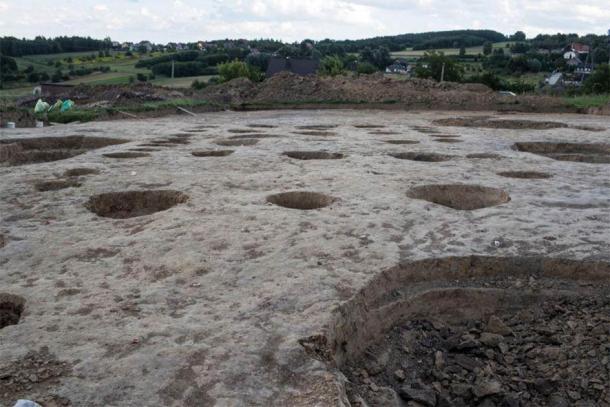Archaeologists excavating in the village of Biskupice, Poland have discovery a mysterious 7,000-year-old ceramic fragment depicting a horned face image. The team of archaeologists were excavating three ancient homesteads at a prehistoric settlement associated with the Linear Pottery Culture (abbreviated as LBK from the German: Linearbandkeramik). During their excavations, they discovered over 3,000 ancient artifacts including “cores” (stone blocks) used to strike stone flakes, obsidian chips that were used to make leather scrapers, wood and bone cutting tools, and sickle blades. However, the horned face image find was the most remarkable of all!
Biskupice is a tiny village located in the administrative district of Gmina Biskupice, within Wieliczka County in southern Poland, about 11 miles (18 kilometers) south-east of the regional capital Kraków. And it was in this village of less than 100 inhabitants that the archaeologists set out to recover artifacts as part of a heritage rescue project before the planned construction of modern homes.
The Discovery Of An Unknown Foreign Deity Or Demon
The horned face image, found on a ceramic shard, is about 4 inches (10 centimeters) long. The image has clearly defined eyes and a nose. It was found “stashed” with a collection of ceramics in a cavity under one of the longhouses. The archaeologists said the face instantly “stood out for its very unusual features.”

This photo clearly shows the eyes, nose and two bumps over the eyes that are presumed to be horns. ( Lukasz Gagulski / Science in Poland )
Project leader Dr. Magdalena Moskal-del Hoyo, from the W. Szafer Institute of Botany , told Science in Poland that the remains of the ancient artifact depict the “stylized outline of a human face with eyes and a nose, and two bumps on the forehead that are reminiscent of horns.” The professor added that this highly unusual artifact is probably related to “the sphere of the sacred.” Archaeologist Marta Korczyńska added that the curious ornament was likely part of a bigger vessel, perhaps a bowl. Dr Moskal-del Hoyo also stated that because of our poor understanding of early Polish cultures “we are unable to conclusively interpret this portrayal.”
Is The Horned Face Image A God From Another Ancient Culture?
While the identity of the god, demon or spirit depicted on the artifact cannot be identified, Professor Marek Nowak, from the Institute of Archaeology at Jagiellonian University in Kraków, told the Polish press that this type of artifact “is evidence that the inhabitants of the settlement had contact with people living in present-day Hungary and Slovakia” where similar ornamental motifs have been found from around the same time period. However, Nowak pointed out that these other artifacts “usually do not have stylized horns.” And, according to the archaeologist, this origin theory is supported by the discovery of obsidian (volcanic glass) tools found at the Biskupice site. Obsidian, or volcanic glass, is not native to Poland and therefore must have been imported.

The Biskupice dig site in Poland where the ancient artifacts and the horned face image were discovered. ( Lukasz Gagulski / Science in Poland )
The LBK ceramic style is believed to have come from the Starčevo-Körös culture in present-day Serbia and Hungary. The earliest LBK ceramics, found on the middle Danube in the Starčevo range, date from about 5600–5400 BC. These pottery artifacts feature paintings of Balkanic cultures.
As animal husbandry increased, the use of stone tools decreased, but according to Douglas Price’s 2000 book Europe’s First Farmers: an Introduction , 500 years before this transition, the post-Mesolithic LBK tool kit consisted of “flint and obsidian blades, and chopping sickles made by lining flint blades inside curved pieces of wood.”
A God Or Demon Of The “Sacred Sphere” From Where?
There is no doubting Dr. Magdalena Moskal-del Hoyo’s claim that the horned face image belonged to “the sacred sphere,” but what does this meaning, exactly.
It is known that the flints discovered were likely from an area in southern Poland, but the obsidian must have come from much further away. Researchers believe the obsidian was probably from the Bükk and Tatra mountains in the northern part of Hungary. Archaeologists have discovered evidence of 7000-year-old mining in these mountains, and they know manufactured cutting products were exported to other LBK cultures. So, the question remains: Where was the horned face image made?
Either, sometime around 5000 BC a farmer in what is Poland today taught himself how to craft a near perfect horned face image, or, more probably, the finely crafted image was made by specialists in Hungary and then made its way to the farmers in Poland. If the latter theory is true, then the horned face image is likely an unknown Hungarian god or demon. Hopefully, archaeologists will learn more about this important Polish discovery and who or what the horned face image represents.
Top image: The mysterious ceramic fragment with the horned face image found in a village in Poland. Source: Lukasz Gagulski / Science in Poland
By Ashley Cowie
Related posts:
Views: 0
 RSS Feed
RSS Feed

















 September 4th, 2020
September 4th, 2020  Awake Goy
Awake Goy  Posted in
Posted in  Tags:
Tags: 
















